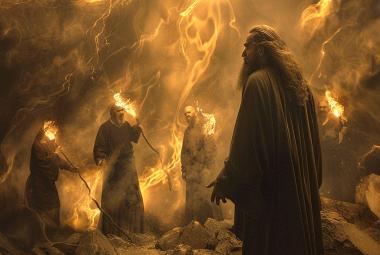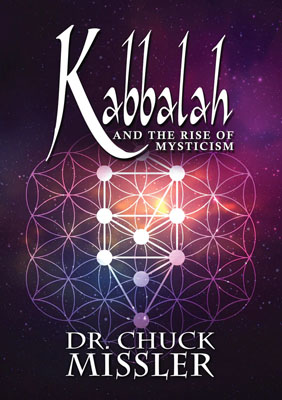Whether disillusioned by the self-imposed blinders and myopia of contemporary “science,” or frustrated by the moral bankruptcy of unbridled materialism, increasing numbers of desperate people are now seeking “answers” outside the realm of natural phenomena and are pursuing the supernatural. The anguished plea of the disenfranchised now begs the question, “Is there anyone out there?”
Beyond the beguiling allure of many contemporary forms of ancient paganism, such as the New Age, Wicca, and others, many people have become attracted to a form of Hebrew mysticism known as Kabbalah. The popular press is speckled with articles of prominent Hollywood personalities who have taken up a popular contemporary version of Kabbalah.
(Kabbalah originally simply designated “received tradition.” Now, generically, it refers to Jewish mysticism in all its forms. Denotatively, however, it refers specifically to the esoteric theosophy that crystallized in 13th century Spain and Provence, France.)
It is particularly paradoxical to find these occultic practices embedded within Judaism, despite the numerous explicit prohibitions against all forms of the occult recorded throughout the very Torah that is so highly venerated among the Jews. It is essential to explore the current resurgence of Kabbalah within a broader historical perspective.
Judaism Redefined
Having rejected Jesus Christ as the Messiah, and enduring the subsequent destruction of the Temple in A.D. 70, Mosaic Judaism was faced with a serious dilemma: the Torah, and all its related practices, had emphasized that “without the shedding of blood there is no remission of sins.” How could there be a continuation of the prescribed sacrifices without an altar and a Temple?
This, and other related issues, resulted in the Council of Jamnia in A.D. 90, which began redefining Judaism and led to the formulation of the Talmud (3rd - 6th centuries) and what is known as the Geonic Era (7th - 11th centuries).
The Talmud
The Talmud is a body of Jewish civil and religious law, including commentaries on the Torah, or Pentateuch, and oral laws handed down through tradition. It consists of a codification of laws, called the Mishnah, and a commentary on the Mishnah, called the Gemara.
The Talmud also includes materials which concern decisions by scholars on disputed legal questions known as the Halakhah (from Hebrew, “to go”). The illustrations and amplifications of the ethical, political, and religious principles involved in the laws are set down in the Haggada.
Two compilations of the Talmud exist: the Jerusalem Talmud (3rd - 5th century A.D.), and the Babylonian Talmud (3rd - 6th century A.D.). Both compilations contain the same Mishnah, but each has its own Gemara.
The Babylonian Talmud became authoritative because the rabbinic academies of Babylonia survived those in Palestine by many centuries (and is referred to in the “Geonic Era”).
After the completion of the Talmud, the Halakhah continued to develop as it was applied to new situations by rabbinical authorities. The Haggada also continued to develop, in the form of compilations, commentaries, and mystical and moral literature.
One of the most important of the works of Talmudic scholarship is the Mishneh Torah by the Spanish rabbi, philosopher, and physician Maimonides; it is an abstract of all the rabbinical legal literature in existence at his time. Among the most widely known commentaries are those on the Babylonian Talmud by the French rabbi Rashi and by certain scholars known as tosaphists, who lived in France and Germany between the 12th and 14th centuries.
The epistemological problems emerge from an excessive veneration of the scholastic commentators over the text itself. This lengthening tether reaches its extremes in the imaginative conjectures that emerged among the Kabbalistic scholars of the 11th and 12th centuries and subsequently.
It is interesting to note that there emerged a Jewish sect in the 8th century known as the Karaites who clung to the strict interpretations of the Scriptures, rejecting the Talmud and the rabbinical traditions that had been incorporated during the first six centuries.
Considered heretical by “Orthodox” Jews, in Czarist Russia they were exempted from abuses such as the double taxation, the pogroms, etc., that fell on Talmudic Judaism.1
Kabbalah Emerges
One of the basic works that was to impact all subsequent mystical movements in Judaism is the Sefer ha-Zohar, (or Zohar for short). This monumental work was composed by Moses de Len (born in Lon, Spain), who lived in Guadalajara, former Spanish kingdom of Castile, until 1290, and thereafter led a life of wandering. De Len was a prolific writer, completely immersed in mysticism. The Zohar, his greatest work, was written over 30 years, in Aramaic.
To lend greater weight to the doctrines expressed in his book, de Len ascribed it to a legendary Palestinian scholar, Shimon ben Yohai, claiming that a Spanish-Jewish scholar and mystic named Moses ben Nahman had found the book in a cave in which Shimon and his son Eleazor had once hid from Roman persecution. When Moses tried to send the book to his son in Catalonia, de Len claims he intercepted it and began making copies, which he then circulated among the learned.
However, de Len failed in this attempt to hide his authorship. Even in his own lifetime a Palestinian mystic, doubting the authenticity and antiquity of the Zohar, came to the royal court at nearby Valladolid to investigate the matter. De Len promised to produce the original copy, but he died before the question of his veracity could be settled. Since the 16th century, considerable evidence has definitely established de Lens authorship of this unique book, which for more than six centuries has exercised a far-reaching influence on Judaism.
The Zohar depicts the Godhead as a dynamic flow of force composed of numerous aspects. Above and beyond all human contemplation is God as he is in himself, the unknowable, immutable Ein-Sof (Infinite “Nothingness”).
Other aspects or attributes, knowable through Gods relation to the created world, emanate from Ein-Sof in a configuration of ten sefirot (realms or planes), through which the divine power further radiates to create the cosmos. Zoharic theosophy concentrates on the nature and interaction of these ten sefirot as symbols of the inner life and processes of the Godhead (see following diagram).

Although subject to some variations in some of the Kabbalistic literature, the ten sefirot are typically:
- Kether Elyon, Supreme Crown;
- Chokhmah, Wisdom;
- Binah, Intelligence;
- Chesed, Love; or Gedullah, Greatness;
- Geburah, Power;
- Tiphareth, Beauty;
- Nezach, Lasting Endurance;
- Hod, Majesty;
- Yesed, Foundation; or Zaddik, Righteous One;
- Malkhuth, Kingdom.
Because the sefirot are viewed as archetypes for everything in the world of creation, an understanding of their workings ostensibly illuminate the inner workings of the entire cosmos and all of history. The Zohar thereby provides a cosmic-symbolic interpretation of Judaism, and of the history of Israel, in which the Torah and commandments - as well as Israels life in exile - become symbols for events and processes in the inner life of God. Thus interpreted, the proper observance of the commandments by man assumes a cosmic significance.
Right at the outset, the concept of Ein-Sof is, among other things, a tragic attempt to depersonalize God. In contrast to the unknowable, capricious (and thus, untrustworthy) Allah of the Quran, or the unknowable nothingness (their words) of Ein-Sof, the YHWH of the Old Testament is a God who delights in making - and keeping - His promises!
(Furthermore, any attempt to chart the inner life of the Godhead, by means of the sefirot or any other, is akin to uncovering the Fathers nakedness, a sin of grave disrespect emphasized in the Tenach itself!2) The disciplines of Kabbalah include meditative practices that promise to enable individuals to share and participate in the diverse dimensions of Gods being. [Similar to the claims of New Age aspirants as well.]
Kabbalistic discipline was understood to be limited to a rarefied elite who were profoundly learned in the main texts of Talmudic Judaism prior to their immersion in Kabbalistic studies. Kabbalistic communities soon developed, generally organized as secret societies of disciples that gathered around a specially gifted mystical teacher (Tziddik). Such communities soon spread from Spain and France to Northern and Eastern Europe and to the Mediterranean basin. By the mid-16th century on, Kabbalah had an increasingly broad appeal among learned Jews, especially in Eastern Europe under the influence of Rabbi Isaac Luria.
Lurianic Kabbalah
16th-century Lurianic Kabbalah (named for its formulator, Isaac ben Solomon Luria) developed dramatically the cosmic aspect of the Zohar. The Lurianic system represented a response to the cataclysmic experience of Jewish exiles expelled from Iberia in the 1490s3 and it projected this experience onto the divine world.
In this system, the Ein-Sof withdrew into itself (tzimtzum) at the outset of creation, making room for the world, but also for evil. A cosmic catastrophe occurred during emanation when vessels of the divine light shattered and the sparks were imprisoned in the world in shards of evil (qelippot).
Luria held that God, as well as Israel, was in need of redemption from exile, and that humanity was assigned the critical role in the cosmic drama of redemption (tiqqun). The human task, through prayer and proper observance of the commandments, becomes nothing less than the redemption (tiqqun) of the world and the reunification of the Godhead.
(It would seem that without you and me, God wont be able to get His act together!? Get serious. However, there was, indeed, a man assigned the critical role in this cosmic drama who was, indeed, fully qualified, worthy, and capable for the role. He is presently sitting on His Fathers throne as you read this.)
Lurias thought provided the basis for transforming Kabbalah into a popular, messianic movement that infused the rabbinic traditions and affected all Jewry, paving the way for Sabbatian messianism (after Sabbatai Zevi) in the 17th century and Hasidism in the 18th century.
Hasidic Judaism
In the Hebrew Bible, the word hasid usually refers to a pious or righteous person.4 (The plural is hasidim). This usage continues in later Jewish writings. By the 11th and 12th centuries, however, the term hasid implied a person involved in a specifically mystical form of contemplative piety.
As such, it came to be applied to a group of German Jewish mystics known as the Hasidei Ashkenaz (German Pietists). The Hasidei Ashkenaz became known for rigorous ascetic practices, such as sleep-deprivation exercises, fasting, and bathing during winter in freezing streams. These practices were designed to suppress the power of physical appetites “for sleep, food, and warmth, for example”and to place the body under the dominion of the soul as it strove for intimate knowledge of God.
Hasidism, as we know it today, developed in the mid-18th century in Eastern Europe from the Kabbalah, and continues today in dozens of Hasidic communities around the world. Some communities consist of only a few hundred members in isolated Jewish neighborhoods of New York City, Los Angeles, and Jerusalem. Other Hasidic groups, such as the Satmar Hasidim and the Chabad-Lubavitch Hasidim, have an international membership numbering in the tens of thousands.
All of these communities trace their origins to a single individual, 18th-century rabbi Israel ben Eliezer, better known to the Jewish world as the Baal Shem Tov (Hebrew for Master of the Divine Name). Through his use of the name of God, the Baal Shem Tov was believed to perform miraculous cures.
Alphanumeric Gymnastics
In Kabbalah, great importance is attached to manifold manipulations of letters and numbers, particularly those involved in many of the Names of God, to which are ascribed magical properties. They believe that concealed within the stories and laws of the Torah are secret guides to the mysterious powers hidden in the various names of God and to the creative force of the letters of the Hebrew alphabet.
(The manipulation of the numeric values attached to the alphabet is called Gametria, and there are virtually unlimited varieties of rules for their use. A study of gematria will quickly demonstrate the proverb within the computer industry that, if you torture the data long enough, it will eventually confess to anything!)
Strangely, we owe a debt for some of the discoveries of the Kabbalistic scholarship over the centuries. It was the esoteric skills of the Jewish Kabbalists who were attached to the courts of Europe that developed the techniques of cryptology which emerged during the Renaissance.
These techniques led to mechanical aids, ultimately culminating in the Enigma coding machines of the Germans during World War II which, in turn, accelerated the development of the computers to defeat them - by John Von Neuman in the U.S. and Alan Turing in Great Britain.
These computers, in turn, have now led to the rediscovery of some of the astonishing properties of the Biblical text that has caused such sensationalism - some valid, much fanciful - today.5
Occult Practices
Anyone with a modicum of Biblical literacy should realize that occult practices are expressly prohibited in the Scriptures. Scripture condemns by name spiritism, mediumism (channeling), and necromancy,6 and various forms of sorcery and divination,7 including astrology8 and magic.9 In ancient Israel, divination was a capital crime; if someone was caught casting a horoscope, or other occultic practice, they were put to death. Why?
Because God is jealous of His uniqueness, and He alone knows what the future holds.10 To intrude on His office is to attempt to intrude on His glory.11 Occult activity also courts deception and betrayal from the demonic realm, and promotes evil under the guise of legitimate religious practice. Occult involvement will eventually lead to judgment for those who refuse to forsake it.12
Notes:
1 Today there are some 30,000 Karaites, concentrated largely in Israel; small communities are also found in the United States, Poland, France, and Turkey.
2 Genesis 9:22-27; 2 Samuel 16:22; et al.
3 Columbus and his crew had to depart by midnight, August 3, 1492. Cf. Personal UPDATE, August 1996.
4 Psalm 32:6.
5 For a thorough discussion see our book, Cosmic Codes – Hidden Messages From the Edge of Eternity.
6 Deuteronomy 18:9-12; 2 Chronicles 33:2, 3, 6.
7 Leviticus 19:26; Deuteronomy 18:9-12, 14; Hosea 4:12; Exodus 22:18; Isaiah 44:25; 29:8, 9; Ezekiel 21:21. Cf.
1 Samuel 15:23.
8 Deuteronomy 17:2-5; 2 Kings 17:15-17; Isaiah 47:9-14
9 Acts 13:8; 19:16-19; Isaiah 47:9, 12.
10 Isaiah 46:10; 45:3, 5.
11 Exodus 19:12, 13; 1 Chronicles 16:22 (David quoting Psalm 105:15).
12 Revelation 22:15; 2 Chronicles 33:6.






